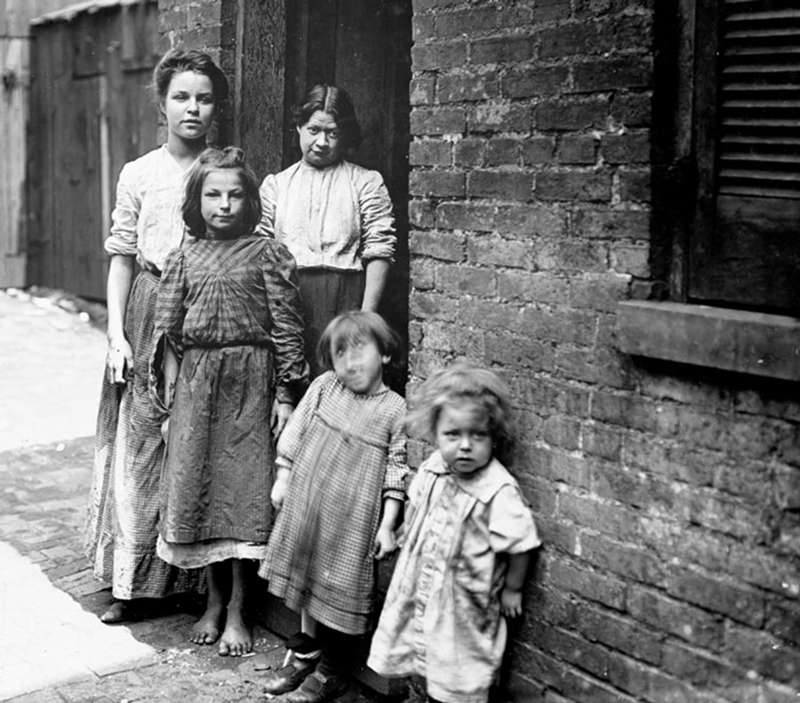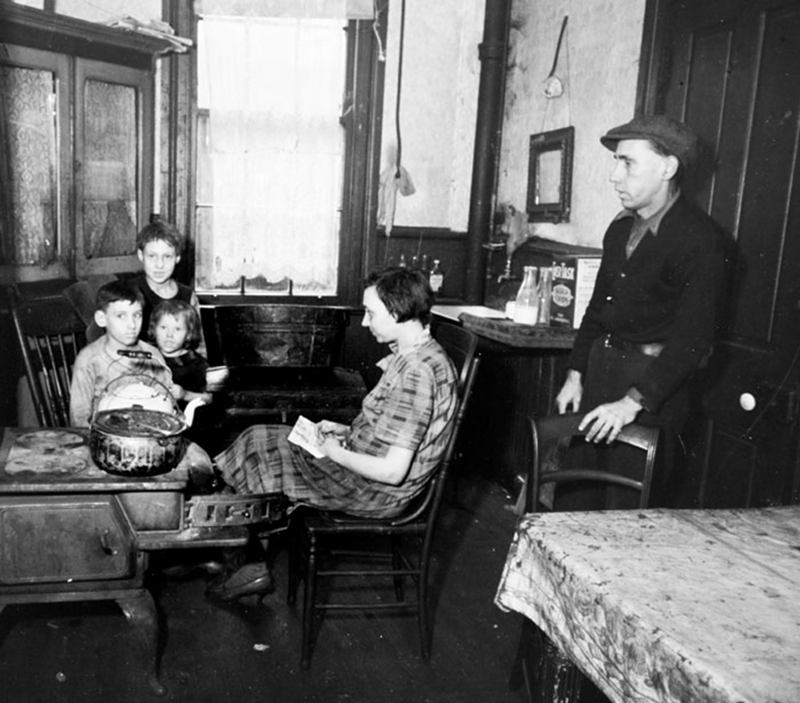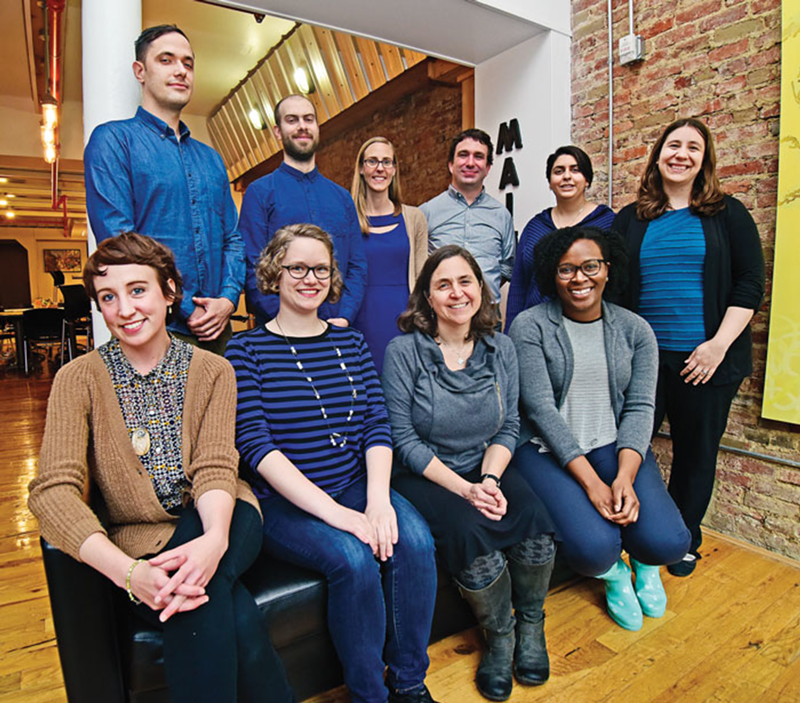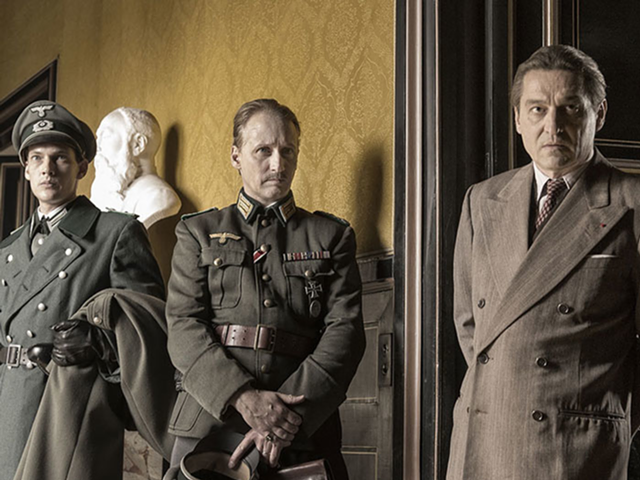A
lthough Over-the-Rhine is a neighborhood about which most Cincinnatians have strong opinions, one thing remains certain: It’s no stranger to change.
When trying to imagine its history, one is confronted with various images: You might imagine it in the 19th century, when up to 10 immigrant families lived under a single tenement roof, fighting to survive, and when filth and refuse were abundant and wild pigs roamed cobbled, gaslit streets. Or you might imagine how it was just 15 years ago, a place of unrest, when sunlight glinted off of SWAT shields and neighbors rallied in the streets.
With the ink barely dry on its federal nonprofit status, the Over-the-Rhine Museum is preparing to undertake a project dedicated to telling the stories of America’s most intact historic district. Although it is inspired by the acclaimed Lower East Side Tenement Museum in New York City, the museum, which is planning for a 2020 opening, will go beyond interpreting just the immigrant experience in one neighborhood. Instead, the story will include residents who moved as a part of the Great Migration during both world wars — when Appalachian people moved to the Midwest — as well as African-Americans who, displaced after the West End was gutted by Interstate 75, settled in OTR during the ’50s and ’70s.
These are the stories that are frequently left untold when people talk about OTR’s history, members of the museum board say. And even when they are told, the stories are often reduced to mere bullet points that form the current narrative of the neighborhood, which has seen intense redevelopment within the last decade that shows no sign of stopping.
“For the last 95 years, the history of Over-the-Rhine includes mostly low-income people,” says Anne Delano Steinert, museum co-founder and board chair. “Those histories are usually erased, and they’re being erased now as all these buildings get rehabbed. By building a museum that celebrates all the eras of Cincinnati’s history, we’re refusing to let those people be erased.”
But to tell the history of America’s largest intact historic district, the board members first want to redefine the way we understand not just Over-the-Rhine, but also history itself. Roughly the same idea had been floating around for a while in the heads of Steinert and another museum co-founder, Ann Senefeld, two strangers born a day apart in Cincinnati.Steinert had the thought first. The Clifton native began her love affair with Over-the-Rhine almost immediately — she remembers riding through the district with her mother in the ’70s, awestruck by the Italianette buildings. By age 12, she was wandering around the neighborhood alone, admiring the architecture and climbing through empty windows to discover what she repeatedly refers to as the “echoes of the past.” By age 14, she had already limited her college options to those that had programs that would allow her to engage with old buildings. Later, she would learn that this was called “historic preservation.”
After getting degrees in historic preservation from Goucher College and Columbia University, Steinert taught social studies for 13 years in New York. Eventually, she decided to move back to Cincinnati in 2008 and refresh her credentials as a public historian and preservationist, enrolling in the University of Cincinnati’s urban American and public history graduate program.
Throughout this time, the idea of an OTR museum lingered in her head — she just didn’t know what to do with it.Meanwhile, in 2012, Senefeld got a similar idea after watching a rerun of The 1900 House, a PBS series with a premise that involves making a modern family live in a house from the 1900s. Senefeld, who is known locally as the person behind the popular Digging Cincinnati History blog and research business, thought the premise might fit well in OTR. Cincinnatians could experience what life was like in the city’s predominantly German period.
But the neighborhood’s roots stretched far beyond its German lore, she soon discovered. While chilly beer caverns, horse-drawn carriages and burlesque halls populate Cincinnati’s cultural imagination, equally interesting memories existed within the community’s Appalachian and African-American past, not to mention the other European cultures that played a part in the community.
After telling people in the city’s history and preservation circles about her idea, Senefeld learned through a mutual friend that Steinert shared a similar dream. The two met and started planning how to bring the museum to life.
Doing that included bringing on Nancy Yerian, a former student of Steinert’s at Clark Montessori and at that time a member of the Ohio History Service Corps. Yerian’s responsibilities there included helping small history organizations, like the OTR museum, become more structured and receive more attention. About a year ago, Yerian helped Steinert and Senefeld develop a board that now includes 14 historians, preservationists, lawyers, contractors and other passionate community members.
The vision of the board began with the concept for the museum itself. Members agree that maintaining an immersive, open and alive space is pivotal to staying true to Steinert and Senefeld’s original dream. Senefeld says DO NOT TOUCH signs in museums aren’t helping anyone understand the history they’re trying to portray.
“We want it to be: ‘Come in, touch, feel what it was like to live in this time period,’ ” she says.
Today, when museums that claim to be cutting-edge want to create an interactive experience, they bring in newer technology — screens and dioramas. Textbooks bore students with a two-dimensional, sweeping scope of America’s past. To experience history firsthand, the OTR museum founders want to let people understand a life in painstaking detail by letting visitors experience a room frozen in amber, a breath away from meeting the tenant themselves.
Like New York’s tenement museum, OTR’s would combine a mixture of real artifacts and historical props to restage apartment rooms as they existed in the past. If a tenant was a baker, that might mean having flour dust on different surfaces. A musician’s room might include the instrument he or she played. The New York museum found that that if a tenant had few possessions — a frequent reality considering the high amount of impoverished people who have lived in tenements — their staff of historians and storytellers had to focus on microscopic details, such as the cost of the fabric or the exact kind of furniture, to interpret an object and its former owner.
The histories being told wouldn’t be limited by the tenement the museum chooses to interpret: those rooms would instead act as entry points into discussing, in-depth, the different cultures, issues and stories that have existed in OTR. Whether it’s used to interpret the time in Cincinnati when narrow streets were lined with German beer gardens and saloons or when they were bordered by crumbling slums, a single building in Over-the-Rhine can also act as a gateway to discussing the larger concept of the American city.
“Architecture is a document of human effort and lived
experience,” Steinert says, tapping the exposed brick wall in her office on the top floor of People’s Liberty’s Globe Building, Cincinnati’s self-described philanthropic lab based in OTR. “The fact that some person put this mortar in between these two bricks — that there’s a trace of what someone’s life was like embedded in this wall that I can sleuth out — is really fascinating to me.”
Steinert pauses and then arrives at her conclusion. “It makes you feel less insignificant.”
Steinert is becoming a history rockstar in Cincinnati, if such a thing exists. She’s the mind behind the People’s Liberty-sponsored Look Here! project, a collection of historic photos framed in lime green contrasted against the location’s current incarnation that you would have inevitably seen when driving or walking through OTR this winter — an attempt to objectively reveal what’s changed over time.
Maybe the most obvious distinction between Steinert’s approach to history and those of other local experts is her
emphasis on public history. Although she’s now earning her Ph.D. at UC, you probably won’t find her in the turgid pages of an academic journal. Instead, you’ll find her walking the
pavement giving street tours, connecting with people — both living and long dead — in the neighborhood.
In her aforementioned office, blue sunlight filters through large windows that look out onto Findlay Market. The interior is trendy and spare, all hardwood flooring and exposed brick. Although it might feel like it, Steinert wouldn’t call it historic.
“Over-the-Rhine’s going through this intense period of change,” Steinert says. “People call it a ‘rebirth’ or a ‘renaissance,’ but all those imply that it was dead, that it had to be reborn again. That’s part of the problem. OTR was still a vibrant neighborhood with lots of stuff going on. It was just filled with low-income people.”
Ten years ago, a mixture of violent crime and reckless demolition earned OTR a place on the National Trust for Historic Preservation’s list of America’s “11 most endangered historic places.” Steinert believes that although gentrification has saved many of the neighborhood’s places from great peril, the history is still under threat.
Echoes of the past are becoming lost, she says, as historic buildings become modernized to fit the wants of new tenants. She sees the People’s Liberty headquarters as an example. “Without this brick wall, you can’t tell this is a historic building,” she says, gesturing toward glass-enclosed cubicles in an open floor plan. “While it’s great that these buildings are being reused, in terms of history, it’s not that great.”
A building accurate to the 19th century would be darker, for one. Around the turn of the century, tenements were so closely crowded together that they prevented sunlight from entering the rooms. Apartments would have been divided off as dozens of tenants coexisted in sweltering heat and choleric conditions.
One of the challenges of finding a permanent space for the museum involves securing a building that has rooms intact from several different time periods. As John Blatchford, a contractor on the museum board, shows some of the tenements the museum is considering at Pleasant and Vine streets, he says there are probably only 20 or 30 residential buildings that are historically intact still standing in OTR. What about a single building with four units true to four different historical periods? It probably doesn’t exist, or isn’t available, Blatchford says. They’ll have to make due with what they can find.
Originally, the museum members were just looking for the most inexpensive building available, until they realized OTR’s development culture wasn’t going to let them get anything cheaply. This could mean shelling out $300,000 for a building that might have cost just $30,000 a decade ago. The museum board is currently in the sluggish process of accumulating funds, mainly through state-based grants, donations, walking tours and a quarterly series called Three Acts in Over-the-Rhine, which features spoken stories on different topics — from Appalachian music to gentrification — in OTR.
When discussing the kind of venue they’re looking for, the board members like to use the term “time capsule”: a building virtually untouched by renovators that still has intact layouts, wallpaper and — maybe most difficult to find — a history of tenants that can help illuminate the neighborhood’s untold past.
It’s something Steinert and the board know they will have to find quickly. As developers hasten to renovate and sell OTR’s tenements, it could only be a few years before the mere possibility of a time capsule might not exist.
Jenn Arens knows that to shape the perception of Over-the-Rhine in a productive way, it will take more than good intentions. As the community education and volunteer coordinator for the Peaslee Center, one of OTR’s oldest surviving nonprofits geared toward public resources and education, she’s heard firsthand the worries longtime residents have about the district.
“To a place like Peaslee, we’re invested in the community
in a way that we have a stake in how the stories are told,”
Arens says during an interview in a spacious meeting room.
Through a window a bulldozer is visible, parked behind the historic former address of the School for the Creative and Performing Arts on Sycamore Street. The field and the building are slated to be renovated by Alumni Lofts, a private developer that has worked on other projects in the neighborhood. Arens admits the development makes her anxious, noting that Peaslee will look unattractive by comparison when the lofts are finished.
Like Steinert, Arens worries about the changing landscape and how it has the ability to impact history and shift what is important to the community. The museum board is currently in the process of starting a collaboration with Peaslee and plans to reach out to other cultural institutions downtown — like the Freedom Center or the Cincinnati Preservation Association — down the line.
Although Peaslee doesn’t have to worry about ever losing its building — they own it outright after a grassroots campaign in the ’80s raised more than $200,000 — Arens says it’s hard seeing so many great organizations disappear.“It’s a struggle just to stay,” she says, adding that although she’s mostly confident that members of the museum board know what they’re doing, they have an enormous responsibility. As a coordinator for the nonprofit, she works with OTR residents almost every day and says many feel neglected not only by the city, but also by history. Telling this story has its own set of challenges.
“You want to tell the stories in a way that’s inviting to folks,” Arens says. “But to talk about the implications of this history, you have to talk about the justice implications of the history.”
Arens, who has helped archive dozens of oral histories from OTR residents, says there’s friction between what the museum wants to tell and what many Cincinnatians want to hear about Over-the-Rhine.
“It’s not marketable,” she says about the larger story of lower-income OTR. “It’s not sexy. It’s not fun. And this neighborhood is being designed as an entertainment district that’s sexy and fun and hip. That’s what it’s been designed from the top down to be.”
The changes aren’t exactly discreet. While OTR’s low-income housing — and housing in general — has shrunk, cocktail bars, high-end boutiques and myriad themed tours abound.
Arens thinks the complicated role of the museum in society should include an inclination toward objectivity, but that the clashing narratives of Over-the-Rhine and the inherently political force behind historical museums make that impartiality harder to attain.
“History and stories are so important, but lots of people want to have a neutral space to learn about history,” she says. “I think what’s playing out is not neutral. It’s riddled with power dynamics. When you’re creating a museum and marketing to new folks, how do you offer them a dose of hard truth?”
Carefully, it might seem. Steinert and the board know that getting many people excited about the project means promoting the German history, even though the 20th-century stories are perhaps more important.
The excitement felt for the Over-the-Rhine Museum is steeped in a historic pride for the neighborhood’s beginnings, Arens says. “People think, ‘Now we can talk about things in Cincinnati that make us feel proud.’ But who is erased by that?”
On a polar Friday night in January, during an impending snow storm, the Mercantile Library’s reading room teemed with a full house. They were there for Ruth Abram, who was delivering a lecture titled “Museums as Vehicles for Social Change.”
Abram, who is the founder of the Lower East Side Tenement Museum in New York, spoke about the hardships she faced in creating her museum in the early ’90s, pointing out that her then-radical museum proposal was initially met with resistance from donors. “They couldn’t see the point of a museum focused on a building and not objects,” she said during the lecture.
“The Lower East Side was then considered dangerous, drug- and crime-infested,” she continued. “No one, they said, would venture there. Who had ever heard of preserving a tenement? No one of importance had ever lived there, they said.”
Although the OTR board is indebted to New York’s tenement museum, in many ways they’re taking a different route than their lodestar. While Abram’s project is renowned for its activism and emphasis on social justice, Blatchford, the board’s contractor, says the OTR Museum will most likely portray the lives of tenants in a way that would let visitors interpret the political aspects for themselves, rather than risk a didactic approach that might leave some disenchanted.
Unlike New York’s tenement museum, OTR’s has, so far, received immediate enthusiasm from the community, if not with donors.“There are a lot of ideas about what should be happening in Over-the-Rhine, some of which might be at odds with each other,” says Yerian, the former student of Steinert’s who helped set up the OTR Museum board. “A role we can play is in showing where the community has been and the challenges faced in the past.”
Yerian says that while finding a permanent space and honing the museum’s mission might take a lot of time and resources, she isn’t worried.
“Any institution is going to face hurtles and challenges. But I’ve been overwhelmed by the community’s reaction,” she says, speaking inside a renovated office space the board sometimes rents on Sycamore.
The room is mostly empty save for a small, riverine watercolor hanging on the wall depicting old Cincinnati, before any recognizable skyline existed. It is itself a gentle insistence to keep in mind that, amid a time of rapid redevelopment, a place will always once have been something else, and something worth remembering. ©
EDITOR’S NOTE: The OTR Museum’s stated mission includes telling the stories of OTR’s populations that are frequently left untold. CityBeat acknowledges that the photography in this package does not represent every story referenced in the article, particularly the African-American experience of the latter 20th century. We were unable to track down such images prior to publication deadline. The historical photos we were able to find and granted permission to use were provided by the Library of Congress. All except one are from 1935; the image on this week’s cover was made in 1908.









